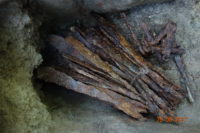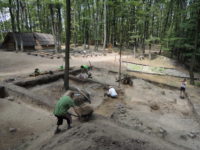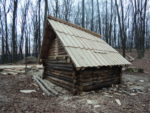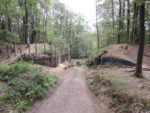 Archaeologists have discovered a hoard of 10th century iron hidden in a medieval oven in the village of Bojná, western Slovakia.
Archaeologists have discovered a hoard of 10th century iron hidden in a medieval oven in the village of Bojná, western Slovakia.
The Slavic inhabitants of the region hid it in a stone oven at the beginning of the 10th century. Iron was in that era was a very precious metal; as the metal “hrivna” it was used for currency.
“The surprising discovery consists of 36 hrivna, bridle bits from a horse harness, two keys from a Slavic settlement and other iron objects,” said head of research in Bojná Karol Pieta from the Archaeological Institute of the Slovak Academy of Sciences, as quoted by the SITA newswire.
Strategically located at the foot of the Považský Inovec mountain range where a pass through the mountains connects the Váh and Nitra river basins, the town’s history long predates the presence of the actual town. The first historical records alluding to Bojná date to the 15th century, but the area was dotted with hill forts defending the pass under the Slavic kingdom of Great Moravia (833 – ca. 906/907).
 One of those hill forts, today known as Bojná I – Valy, has been found to be a rich source of archaeological materials even predating the Great Moravian fortifications. The oldest writing in Slovakian history were found there, Latin inscriptions dating to the late 8th, early 9th century, the earliest days of Christianity in the area. It was in the 9th century when Great Moravia was at its zenith that the fortress became a hive of activity. The remains of several blacksmith shops from this period have been unearthed and their work products have been found by the thousands — farming and craftsmen’s tools, battle axes, knives, swords, seaxes, horse fittings, chain mail, spurs. Some of the weaponry and armature is gold and silver plated, evidence of the presence of a significant number of elite warriors.
One of those hill forts, today known as Bojná I – Valy, has been found to be a rich source of archaeological materials even predating the Great Moravian fortifications. The oldest writing in Slovakian history were found there, Latin inscriptions dating to the late 8th, early 9th century, the earliest days of Christianity in the area. It was in the 9th century when Great Moravia was at its zenith that the fortress became a hive of activity. The remains of several blacksmith shops from this period have been unearthed and their work products have been found by the thousands — farming and craftsmen’s tools, battle axes, knives, swords, seaxes, horse fittings, chain mail, spurs. Some of the weaponry and armature is gold and silver plated, evidence of the presence of a significant number of elite warriors.
 The fort was conquered in the early 10th century by invading Hungarians who burned it down. It was never rebuilt and the people who had lived and worked there moved on, leaving behind their cached valuables in the rubble. The stone oven containing the iron pieces was found on the west side of the Great Moravian-era fortification. They had been placed in an earthenware vessel and then stashed in the oven, a brilliant hiding place when there’s a real threat of fire and destruction looming. In fact, it was so effective that archaeologists found the vessel intact and undamaged, unmoved even. It stood in the same exact spot where some 10th century Slav left it doubtless in the hope of recovering his treasures when the carnage was over.
The fort was conquered in the early 10th century by invading Hungarians who burned it down. It was never rebuilt and the people who had lived and worked there moved on, leaving behind their cached valuables in the rubble. The stone oven containing the iron pieces was found on the west side of the Great Moravian-era fortification. They had been placed in an earthenware vessel and then stashed in the oven, a brilliant hiding place when there’s a real threat of fire and destruction looming. In fact, it was so effective that archaeologists found the vessel intact and undamaged, unmoved even. It stood in the same exact spot where some 10th century Slav left it doubtless in the hope of recovering his treasures when the carnage was over.
 Archaeologists are currently working on a reconstruction of the east gate of the Bojná I – Valy fortifications. This 9th century Great Moravian monumental gate was enormous with a tower 40 feet high and thick defensive walls to match. The hill fort already has a few modest reconstructions — three private dwellings — from its heyday, but the hope is the added drama of the reconstructed 9th century gate will draw tourism to the site. Construction is scheduled to be complete in the middle of next year.
Archaeologists are currently working on a reconstruction of the east gate of the Bojná I – Valy fortifications. This 9th century Great Moravian monumental gate was enormous with a tower 40 feet high and thick defensive walls to match. The hill fort already has a few modest reconstructions — three private dwellings — from its heyday, but the hope is the added drama of the reconstructed 9th century gate will draw tourism to the site. Construction is scheduled to be complete in the middle of next year.
How do they know that the two keys are from a Slavik settlement? Is there something distinctive about them, or are the just assuming that this was not a supply of iron from somewhere else?
In this context, the 9th and 10th century Hungarian invasions of Europe are indeed key. The medieval Saxon chronicler Widukind of Corvey (c. 925 – after 973) in his three-volume chronicle of 10th century Germany (‘Rerum gestarum Saxonicarum’/ ‘The Deeds of the Saxons’), Bk. I, here, e.g. chapters XVIII. De Ungariis, qui et Avares dicuntur, XX. Qualiter Ungarii Saxoniam vastabant or XXXV. Qualiter rex Heinricus [Frankish king ‘Henry the Fowler’, 876 – 936AD] novem annos pacis habuerit. However, new fortified towns and hillforts as a defense against Magyar and Slav invaders were built and a new elite cavalry force (‘ex agrariis militibus nonum’) trained:
————
“… Et primum quidem ex agrariis militibus nonum quemque eligens in urbibus habitare fecit, ut ceteris confamiliaribus suis octo habitacula extrueret, frugum omnium tertiam partem exciperet servaretque. […] Vilia aut nulla extra urbes fuere moenia. […] Post haec Pragam adiit cum omni exercitu, Boemiorum urbem, regemque eius in deditionem accepit; de quo quaedam mirabilia predicantur, quae quia non probamus, silentio tegi iudicamus. Frater tamen erat Bolizlavi qui quamdiu vixit imperatori fidelis et utilis mansit. Igitur rex Boemias tributarias faciens reversus est in Saxoniam.”
————
PS: What else than ‘Slavic’ would those two ‘keys’ be ? :confused:
What else could the keys be indeed. They are iron in an iron stash, rather than lying where they were left/lost in a settlement. In the post about the copper axe being found in Switzerland the real news is that it came from the other side of the Alps, somewhere in present-day Italy.
So I do not see any direct evidence that they are Slavic keys. Why not Saxon, for example?
You definitely have a point, Trevor:
While metal finds from the Stone Age are ‘significant’ per se, I simply don’t know about the significance of ‘Slavic’ metal finds. As indicated, the period was a hostile one, and (e.g. after battle) Slavic, Magyar (‘Ungarii’) or Frankish ‘metal’ might have simply been ‘collected‘ (In case I understood the text correctly, at least one horse was involved).
Widukind, e.g., talkes of ‘agrariis militibus’, rural fighters, of which every ninth (‘ex agrariis militibus nonum’) was provided with a fort [and probably metal and horses] but he had to provide dwelling places (‘habitacula’) to the other eight, and the chosen one was entertained by his eight mates and he stored one third of the harvest (‘frugum omnium tertiam partem’).